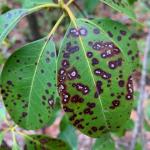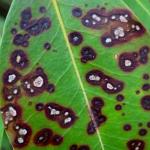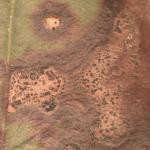Pseudocercospora leaf spot of Mountain laurel
Pathogen
The fungal pathogen Pseudocercospora kalmiae (formerly Cercospora) is responsible for the disease (Braun 1996).
Hosts
Mountain laurel (Kalmia latifolia) is the primary host. Presumably, other species of Kalmia can also serve as host for the disease. Pseudocercospora kalmiae is believed to be specific to Kalmia and does not infect other ericaceous plants (Sinclair and Lyon 2005). On rhododendron and azalea (Rhododendron), P. handelii causes similar leaf spot symptoms (Sinclair and Lyon 2005).
Symptoms & Signs
Pseudocercospora leaf spot is a very common disease on mountain laurel throughout the region. Infections result in circular to irregularly-shaped foliar spots. When numerous, the spots can coalesce to create larger necrotic blotches. The spots often appear purple to brown on the margins with tan-colored centers as the dead tissue dries out over time. Severe infections can consume large portions of the leaf and lead to reductions in growth and flowering. Most infections develop shortly after new leaves begin expanding in the spring and persistent wet and humid weather allows for spore germination and dispersal. Older, infected leaves provide the necessary inoculum for infection of newly developing leaves. Even badly infected leaves are usually held through the winter. Plants growing in deep shade or understory settings suffer higher rates of disease. For that reason, placement of mountain laurels in part to full sun settings can help to avoid the disease.
Management
Overall, Pseudocercospora leaf spot is not considered a serious threat to the health of infected mountain laurels. Prune and discard infected older leaves before new growth emerges. These older leaves serve as a source of inoculum for new infections. Pruning to improve air flow and light penetration into the canopy can also help to reduce disease incidence and severity. For badly infected plants in shaded settings, protective fungicide applications as new leaves are expanding may be helpful in decreasing disease severity. Copper-based products, mancozeb and propiconazole should have utility against P. kalmiae. Avoid using chlorothalonil, which is increasingly linked to health issues in bees (O’Neal et al. 2019), and any applications while plants in flower.
Citations
Bruan, U. 1996. Taxonomic notes on some species of the Cercospora complex (IV). Sydowia 48(2): 205–217.
O’Neal ST, Reeves AM, Fell RD, Brewster CC, and Anderson TD. Chlorothalonil exposure alters virus susceptibility and markers of immunity, nutrition, and development in honey bees. Journal of Insect Science 19(3): 14, https://doi.org/10.1093/jisesa/iez051
Sinclair WA and Lyon HH. 2005. Diseases of Trees and Shrubs, 2nd edn. Cornell University Press, Ithaca, NY.



